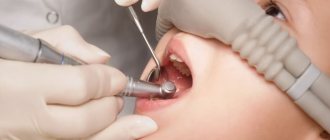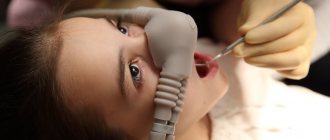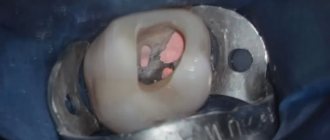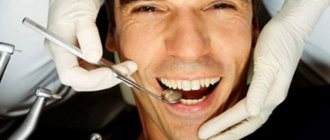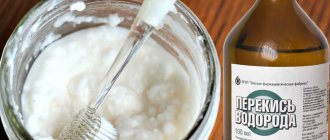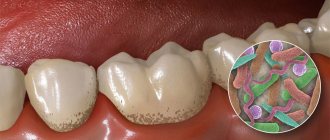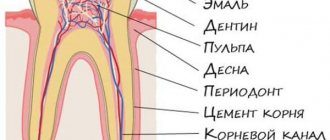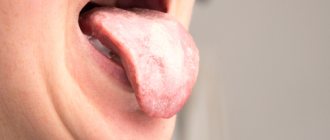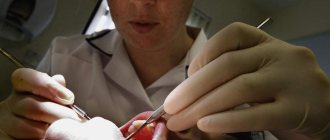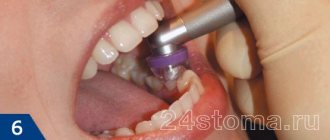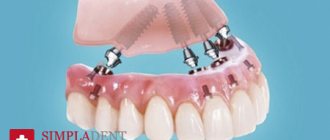Small concentrations of nitrous oxide cause a feeling of intoxication (hence the name “laughing gas”) and slight drowsiness. Nitrous oxide does not cause respiratory irritation. Nitrous oxide dissolved in blood plasma practically does not change, is not metabolized and does not bind to hemoglobin. After inhalation ceases, it is excreted (within 10-15 minutes) through the respiratory tract unchanged.
Inhalation of nitrous oxide with oxygen occurs using a comfortable mask, a pleasant aroma and a feeling of relaxation are felt. This procedure is completely safe, since nitrous oxide does not cause side effects or addiction, allergic reactions, is quickly and easily removed from the body, and has no aftereffects. This technology is used in both pediatric and adult dentistry. Nitrous oxide has been used in countries with progressive dentistry for more than 30 years. In the USA, Israel, and Great Britain, almost 100% of pediatric dental clinics use this technique on a daily basis. Therefore, it cannot be called new, but rather proven.
Can anesthesia be replaced with sedation?
The fundamental difference is that in the first case the person is conscious, while in the second he is not.
Treatment during sleep at the Atribeaute Kids clinic is carried out using the safe drug “Sevoran”. During the procedure, the child sleeps soundly under the supervision of the anesthesiology team.
With oxygen sedation, the patient relaxes, the level of stress decreases, but he is conscious, maintains contact with the doctor and assistant, and all reflexes are completely preserved.
The choice of treatment method and sedation is always determined by the doctor based on diagnosis, indications and contraindications.
Nitrous oxide - oxygen sedation in pediatric dentistry. Technology and application experience
Nitrous oxide - oxygen sedation (NAS), an inexpensive and effective alternative to general anesthesia, has become firmly established in the dental practice of many developed countries of the world: the USA, Germany, France, Austria, Australia, etc. Nevertheless, this technique is used in Russian (Soviet) dental practice For some reason it was not used until recently.
In Russia, as well as throughout the world, anesthesia using nitrous oxide has always been widespread. It is still widely used in surgical practice, operative gynecology, surgical dentistry, as well as for pain relief during childbirth, relief of pain attacks in acute coronary insufficiency, myocardial infarction, acute pancreatitis and other pathological conditions accompanied by pain that is not relieved by conventional painkillers. . ZAX sedation is making its way into Russian dentistry, and especially in the field of pediatric dentistry.
The article describes the main properties, indications and contraindications, as well as experience with the use of nitrous oxide - oxygen sedation in children.
To provide high-quality dental care to a child, it is necessary to create conditions in which he feels calm and comfortable. Anxiety and fear interfere with the work of a dentist, and often make it impossible or seriously affect the quality and prognosis of treatment.
Unfortunately, in our country the practice of treating children against their will is still widespread. This not only makes it difficult to carry out adequate diagnostics, but significantly narrows the choice of treatment methods and materials. Treatment of children who behave well at the initial appointment can also turn into a problem. Many pediatric dentists have encountered a situation where, during one of the visits, the child simply closes his mouth and does not allow him to complete what was planned.
With the advent of modern sedation technology, dentists can provide their patients with truly stress-free treatment.
Sedation is understood as minimal depression of consciousness, in which protective reflexes, the ability to breathe independently, and verbal contact are preserved. The choice of a sedative drug in pediatric practice largely depends on the experience of the doctor and the technical equipment of the clinic.
In the West, nitrous oxide is most often used in pediatric dentistry - oxygen sedation (NAS). Nitrous oxide is an inert gas with a subtle sweetish odor; when mixed with oxygen, it provides the safest and most harmless sedation for the patient. ZAX has been regularly used in dentistry since 1948, and currently, in 80% of cases in children, this type of sedation is used.
Nitrous oxide is supplied using special equipment. The device is a rotameter that allows you to adjust the ratio of gases in the mixture, a reserve bag, a breathing circuit with a nasal mask and a source of gases (cylinders or a centralized system). The gases exhaled by the patient are evacuated by high-speed suction.
Indications for the use of ZAX in pediatric practice are:
- The need to relieve moderate fear of dental surgery in a cooperative child. Usually these are children over 3 years old.
- The first treatment at the dentist, which allows you to form a stereotype of a non-scary treatment.
- Increased gag reflex.
- Traumatic interventions (local anesthesia, removal, preparation of carious cavity).
- Long-term treatment.
Contraindications to ZAX are:
- The child has a strong fear after a negative experience of treatment at the dentist and reluctance to contact the doctor.
- The child is too young when he is not ready to cooperate.
- Mental illnesses and intellectual disabilities that interfere with the ability to negotiate with the child.
- Impaired nasal breathing (adenoids, ARVI). The child will breathe through the mouth and will not be able to use the nasal mask.
- A full stomach, as nausea and vomiting may occur. The last meal should be taken 2 hours before the start of sedation.
- Hyperexcitability, since there is a possibility of a paradoxical reaction to sedation. Having some experience, the doctor, analyzing the child’s behavior during the consultation, can predict what impact the ZAX will have on the patient.
It is important to remember that successful use of ZAX is only possible in combination with the use of behavior management techniques. Trying on a mask takes place in a playful way. The doctor explains to the child in an accessible form what will happen to him. It is important to obtain the patient’s voluntary consent to wear a mask: this is the first component of success. In children's practice, scented masks and masks of various colors are used, which makes the choice and the procedure itself more pleasant.
Introduction to a state of sedation begins with the supply of 100% oxygen at a rate of 4-6 l/min, with the gradual addition of nitrous oxide. The permissible concentration of nitrous oxide is 50%. The most optimal ratio at which the planned treatment can be carried out is 30% nitrous oxide and 70% oxygen. However, adjusting the concentration of nitrous oxide depends on the effect, and in each case this is an individual indicator that is recorded in the map. After the start of inhalation, the blood is saturated with gas within 5-7 minutes. The difference between ZAX and other sedative drugs is the rapid onset of sedation and the absence of a trace effect; nitrous oxide is completely eliminated from the body within 5-10 minutes of inhalation.
For the most unpleasant and painful procedures, such as tooth extraction with a diagnosis of periodontitis, it is possible to temporarily increase the concentration of nitrous oxide up to 50%. Nitrous oxide has an analgesic effect and potentiates the action of local anesthetics. Even if the child is scared or feels discomfort, after the end of the manipulation he quickly calms down and gives the opportunity to calmly continue the treatment. The use of ZAXS allows for complex and fairly long-term treatment. For example, treatment of pulpitis followed by restoration with composite materials or standard crowns in one visit. Completion of work must be carried out on traces of nitrous oxide. The exit from the state of sedation should be smooth and ends with inhalation of 100% oxygen for 5-10 minutes. At this time, the doctor can communicate with the child, reinforcing his positive impressions of visiting the clinic. The effect of ZAX is due to nonspecific depression of the central nervous system.
Comfortable, relaxed state; pleasant mood; soft, relaxed, inhibited body movements; lack of resistance; deep breathing; decreased motor activity of the eyes, easily fixed gaze; decreased perception of sound are all symptoms of sedation. The patient may be disoriented and easily suggestible. The use of ZAX significantly facilitates the treatment process for both the child and the dentist. Children develop a positive attitude towards dental visits, which instills in them a culture of dental health. New prospects open up for the pediatric dentist to provide higher-quality, more extensive, smoother treatment!
When will nitrous oxide treatment be effective?
1. Age over 3 years. Children are not psychologically ready for this type of manipulation and may be scared.
2. The child sits in the dental chair by himself - without panic fear or hysteria, but at the same time experiences slight discomfort. In this case, the oxygen mixture will help you relax and take your mind off unpleasant sensations.
3. Nasal breathing. The mask should remain on the face throughout the entire procedure, tightly covering the nose. This is due to the fact that the effect of the gas occurs gradually. First, the patient breathes pure oxygen, then the anesthesiologist gradually changes the gas ratio, increasing the nitrogen concentration. If you periodically remove or adjust the mask, the desired effect will not be achieved.
A few recommendations before using nitrous oxide-oxygen
If you or your child is undergoing sedation, you must:
- firstly, you need to limit your food intake before the visit (a light snack is enough), because a full stomach can cause dizziness or mild nausea;
- secondly, the dentist should be warned about respiratory diseases, if any, as they may interfere with the achievement of the effect of sedation.
The doctors of our clinic will carefully and professionally perform sedation using nitrous oxide-oxygen so that visiting the dentist will be a pleasant and desirable procedure for you!
Indications for treatment under ZAX
One of the main advantages of nitrous oxide is its safety: the gas is eliminated from the body in the shortest possible time and in an unchanged state. To recover from the state of sedation, no special antidotes are required, which is very important when treating children’s teeth. After 10–15 minutes, the little patient returns to his normal life and does not feel any side effects. Dental treatment with nitrous oxide for children is carried out very often and has a number of indications.
- Fear of the dentist. Any treatment under sedation can reduce fear of the doctor. Few children are not nervous before the appointment, so sedation is an ideal procedure for relieving stress.
- Preschool age. At a very young age, the use of potent drugs and tranquilizers is prohibited or not recommended. In this regard, nitrous oxide is a better solution.
- Pronounced gag reflex. Laughing gas not only does not provoke, but even suppresses the gag reflex.
Experts recommend using nitrous oxide in dentistry for children for no more than 1 hour. During this time, a fairly large number of manipulations can be performed, including treating pulpitis or periodontitis. If longer or complex treatment is required, then it is better to split it into several stages.
Medical, food and technical gas
The scope of application of laughing gas is quite wide. Its properties allow it to be used for medical purposes for inhalation anesthesia; in the food industry it is used as a propellant, that is, a means that helps in whipping various mixtures, and also as a “packaging gas” - a substance that is pumped into packaging to increase the shelf life of products .
Industrial gas contains a large amount of impurities that are removed from the substance for medical purposes. Technical nitric oxide is cheaper and more accessible, so it often falls into the hands of dishonest sellers. They sell “laughing gas” to naive and gullible youth, assuring them that it is a pure and tested, absolutely safe product.
Often the “safety” of a product is confirmed by the fact that the poison will not be used in medicine.
Those who use nitrous oxide do not take into account the fact that in medicine it is not just a special purified gas that is used, it is also mixed with oxygen in a special proportion, and is also supplied intermittently, that is, for a very short period of time.
The drug is given under the supervision of an anesthesiologist; it is mainly used for short interventions in dentistry, as it “dissipates” quite quickly. Also, a special mixture is given to women in labor at the peak of contractions, but in small quantities, because it does not affect the condition of the fetus. But this is not done from balloons, but with the help of modern equipment that strictly doses the narcotic substance.
For more complex interventions, combined anesthesia is used, in which nitrous oxide is combined with other drugs: analgesics and muscle relaxants. It would be superfluous to mention that during surgery with anesthesia, an anesthesiologist is present, and the patient himself is constantly under the supervision of devices.
When using “laughing gas” from a can or balloon, it is impossible to guarantee either the purity of the product or its dosage. So an “overdose” of such “joy” can easily result in respiratory arrest and death.
hangover cure
In the basement of the Pneumatic Institute, the young chemist Humphry Davy observed the Watt-Beddows machine and at the same time tried on himself the different gas mixtures that the machine produced (we talked about another valuable observation made by Davy in the material “Chrysopoeia of Water”). In 1800, in his book Researches, Chemical and Philosophical, Davy described the extraordinary effect of one of the gases - nitrous oxide, which he was able to isolate in its pure form: it helped him cope with a hangover. “After the third inhalation, I did not feel a headache, a pleasant excitement arose, my willpower was weakened, bright ideas quickly flashed through my mind; I walked around the room and was very excited for several minutes.”
The idea to relieve a hangover with nitrous oxide came to the chemist for a reason - he had already breathed this gas before. At the same time, he wrote, “increased muscle activity was accompanied by very pleasant sensations. <…> I laughed, staggered and tried to speak, but I couldn’t utter a word.”
Davy called nitrous oxide “laughing gas” - and this name, and at the same time the substance itself, quickly became popular among the people. Beddoes was still figuring out whether nitrous oxide helped against tuberculosis - and British nobles had already begun to hold social events where bags of laughing gas were served instead of wine and delicacies. According to contemporaries, at these parties some “ran up and down the stairs and throughout the house, saying strange things,” others “lost the feeling of their own weight,” and still others “felt like the sound of a harp.” There were also those who described the sensation as “returning from a walk in the snow to a warm room.”
In general, the entertainment that British aristocrats became addicted to in 1799 would be called either recreational drug use or substance abuse by modern people, depending on the context.
Life Made Easier: A Cure for Quarrelsome Wives is an 1830 satirical engraving of Humphry Davy administering a dose of laughing gas to a woman.
CC0
Share
No one at that time could explain exactly how nitrous oxide “has fun.” Moreover, even now this is not completely clear. Experiments on rats showed that it blocks NMDA receptors, which causes dopamine to be released in the areas of the brain responsible for pleasure. From a neurophysiological point of view, these processes should indeed be responsible for feelings of joy and positive emotions. But no one has yet experimentally confirmed this in humans. Davy and his followers did not know that the fun caused by the gas did not pass without a trace for them. Any substance that produces a feeling of pleasure can be addictive—nitrous oxide is no exception. The release of dopamine, which brings laughter and good mood, is associated with the formation of psychological addiction if it is released in certain areas of the brain. The fact that those addicted to laughing gas do not face full-blown chemical dependence has not been proven by anyone for three centuries. Although no one has provided clinical examples of chemical addiction to N2O. There are some considerations that the gas does not act strongly enough on dopaminergic pathways and neurons do not lose sensitivity from its influence: this, in theory, should abolish the withdrawal syndrome. But all this does not prevent nitrous oxide, so cheap, accessible and easy to use, from ruining addicted consumers.
Forbidden Air
Poe's cousin, George, also took part in the popularization of laughing gas when he came up with a way to liquefy it. Before that, nitrous oxide had to be carried in huge bags, it was expensive and inconvenient, especially compared to injectable analgesics - for example, morphine, which was already gaining popularity in the second half of the 19th century. Liquefied nitrous oxide took up much less space; bags were replaced by metal cylinders, which settled in dental offices for a long time. And from there they went to parties.
Nitrous oxide existed in this capacity throughout the 20th century. And if the circulation of medical nitrous oxide could still be somehow controlled, then the smaller cylinders that were used to whip cream in restaurants slipped away from this control. Therefore, it was not difficult to obtain laughing gas. In addition, it was inexpensive - for example, at an American rock festival in the 1970s, gas cost 25 cents per balloon.
The philosopher Bertrand Russell in the 15th chapter of “The History of Western Philosophy” recalls, with reference to William James (the same one with whom we began our story), the following anecdote about a certain lover of laughing gas: “Whenever he was under the influence of this gas, he knew the secret of the Universe, but when he came to his senses, he forgot it. Finally, by great effort, he succeeded in writing down this secret before the vision disappeared. Fully awake, he rushed to look at what he had written down. It was: “The smell of oil is everywhere.”
Apparently, Russell made a mistake with the source and slightly changed the quote - there is reason to believe that this is a reference to the experiments of the physician Oliver Holmes not with laughing gas, but with ether, which had nothing to do with the secret of the Universe, and for Holmes everything smelled not of oil, but turpentine. Nevertheless, it was Russell’s version that became widely known; Letov sang “eternity smells like oil,” and laughing gas, under the influence of which James studied Hegel, in addition to euphoria, can actually cause hallucinations.
Despite the ambiguity of its effects, laughing gas not only did not lose its audience - but, on the contrary, even increased it as competitors were criminalized. By the late 2000s, about 15 percent of teenagers in the United States had tried nitrous oxide at least once in their lives. And in its homeland, Great Britain, by 2016 it had become the eighth most popular drug. At least one in three people in the kingdom were personally acquainted with it - while less than a percentage of British adults took opioids. It is unknown how many consumers of laughing gas there are in Russia, although, judging by individual medical studies, they exist, and there are many of them.
There are more and more studies of the consequences of consuming laughing gas around the world - and we are learning more and more about the possible side effects, which, as it turns out, laughing gas also has. Inhalations themselves are usually harmless: the psychogenic effect of the gas wears off within five minutes, since it does not stay in the blood for long and exits back through the lungs. Although disorientation in space and possible hallucinations can, of course, lead to injuries - especially if the person is driving a car.
But “fun breaks” can also have long-term consequences. Nitrous oxide in large quantities oxidizes the cobalt in the vitamin B12 molecule and disables it. And B12, in turn, is involved in DNA synthesis. Therefore, chronic inhalations can lead to a decrease in the number of red and white blood cells in the blood. In addition, disturbances in vitamin metabolism lead to the accumulation of methylmalonic acid, which causes damage to the myelin sheaths in the spinal cord and, as a result, neurological disorders. They are often described by researchers from China: patients complain of weakness, instability of gait and goosebumps.
Amid growing demand for laughing gas, governments in several countries have decided to outlaw nitrous oxide. In 2016, the UK toughened penalties for the illegal production and sale of laughing gas (however, this again applies only to medical nitrous oxide, while “food grade” laughing gas remains readily available). Northern Ireland also passed such a law - in 2022, after the death of a fifteen-year-old teenager.
In Russia, since January 1, 2022, Federal Law No. 472-FZ “On limiting the circulation of nitrous oxide in the Russian Federation” has been in force. According to it, the production, manufacture, supply, storage, transportation and shipment of nitrous oxide for purposes other than medical, industrial or technical use are prohibited. In addition, the sale and marketing of such products is prohibited, and nitrous oxide itself is considered an “intoxicating substance.”
How is nitrous oxide used in dentistry?
Nitrous oxide, or laughing gas, as it is popularly called, was invented at the end of the 18th century by physicist John Priestley. For a long time, the invention could not be used: the gas with a pronounced sweetish taste was absolutely useless at first glance, but had a number of interesting properties. After inhalation, the person became cheerful, relaxed and experienced a feeling similar to intoxication. As usually happens, fans of this gas, or rather, its effects, quickly appeared. Nitrous oxide was used by clowns and circus performers to further excite and make the audience laugh. Over time, another interesting property was discovered: while under the influence of laughing gas, people did not seem to feel pain and treated it quite calmly. Dentist Horace Wells was the first to use nitrous oxide in dental treatment. Despite the fact that the first experiments gave positive results, public experiments were unsuccessful, and in one case the patient almost died. His colleague Wells Morton was more successful in using nitrous oxide, so he is considered a pioneer in this field. Of course, in the past, the gas formula and dosage were far from perfect, so treatment with nitrous oxide was not so predictable. In its modern version, sedation with nitrous oxide has been carried out since the late 40s. It was then that doctors began adding oxygen to the mixture and using special devices, including cylinders, a rotameter and a mask.
